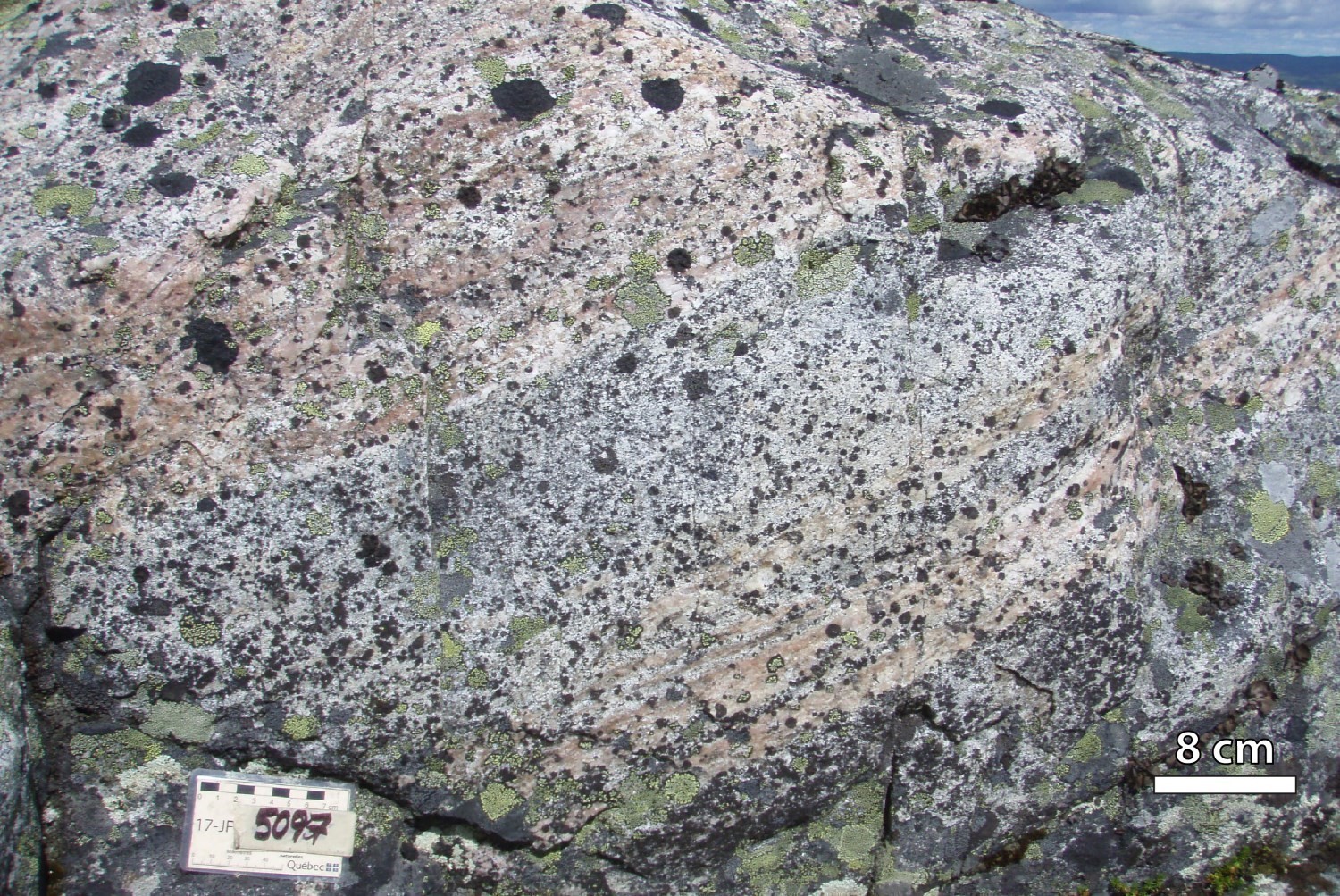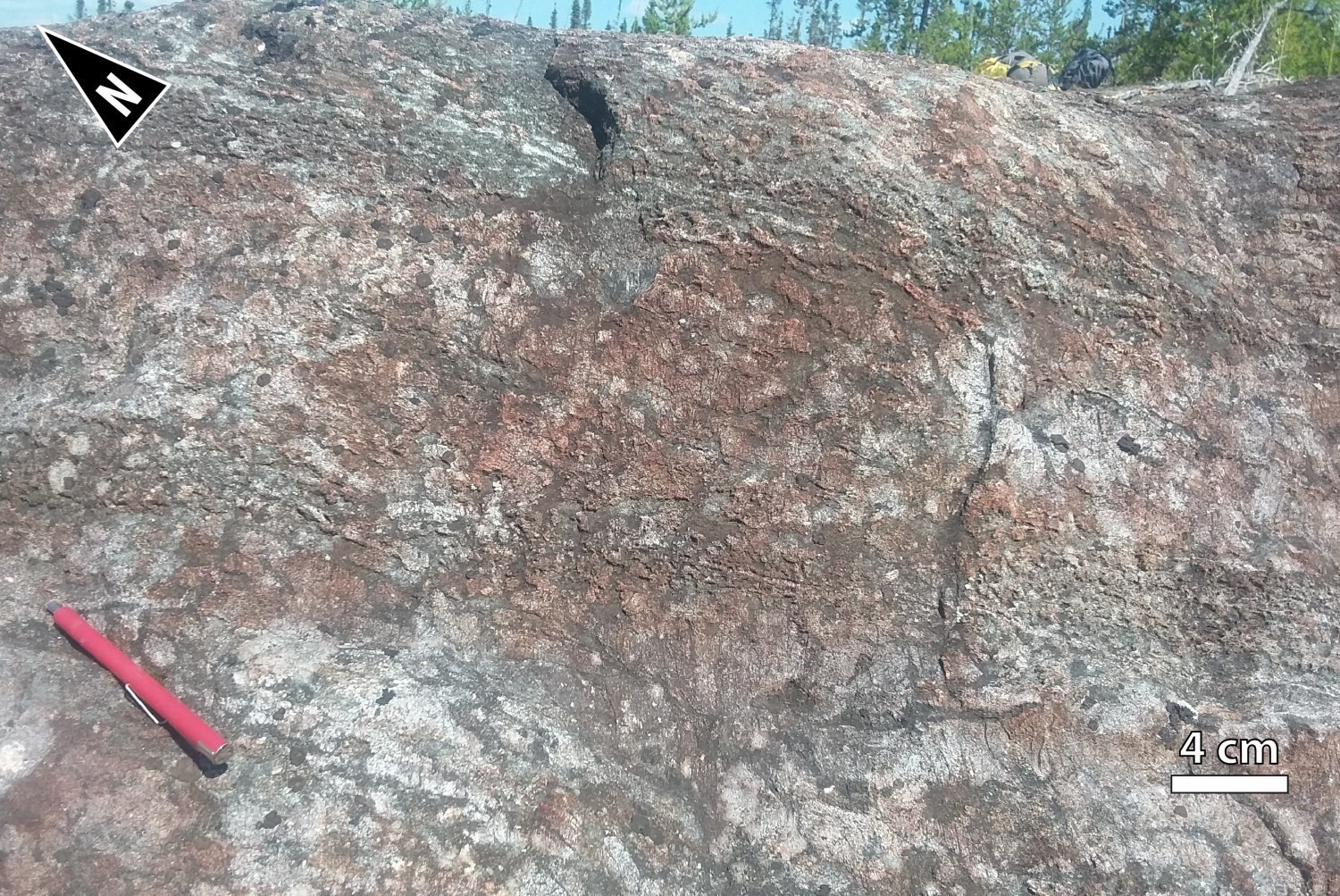
Last modified:
DISCLAIMER: This English version is translated from the original French. In case of any discrepancy, the French version shall prevail.
| Author: | Beauchamp, 2020 |
| Age: | Neoarchean |
| Stratotype: | None |
| Type area: | Cadieux Lake and Bohier Island areas (NTS sheet 33A01 and 33A02) |
| Geological province: | Superior Province |
| Geological subdivision: | Opinaca Subprovince |
| Lithology: | Tonalite, gneiss, diorite, gabbro, amphibolite, peridotite |
| Category: | Lithodemic |
| Rank: | Complex |
| Status: | Formal |
| Use: | Active |
None
Background
The Maingault Complex is a new lithodeme introduced following the Ministère’s mapping work in 2018 (Beauchamp, 2020). It includes tonalitic rocks (I1Da) identified in the south portion of sheet 33A01 during the Bohier Island regional mapping campaign (Beauchamp et al., 2018). The unit is named after Maingault Lake located in this area.
Description
The Maingault Complex is a package of intrusive and gneissic rocks that are locally migmatized. Three informal units were defined within the complex. The largest area is occupied by the biotite-hornblende tonalite and quartz diorite unit, which are banded to gneissic (nAmng1). A mafic package of foliated pyroxene-hornblende gabbro, diorite and amphibolite (nAmng2), and an ultramafic package comprising foliated peridotite sills exhibiting a cumulate texture (nAmng3), are less significant.
Maingault Complex 1 (nAmng1): Foliated Biotite-Hornblende Tonalite and Quartz Diorite, Banded to Gneissic
 Unit nAmng1 consists of an assemblage of banded, locally gneissic and weakly migmatized tonalite and quartz diorite. The rock is medium grey in altered surface and light to medium grey in fresh exposure, foliated and granoblastic. It is fine to medium grained. There are bands and enclaves of granoblastic hornblende diorite within this unit, and three types of granitic injections: thin bands (millimetric to centimetric) of hornblende granite resembling mobilizate, medium-grained massive granite and late massive granite, coarse-grained to pegmatitic, which cuts all facies. In unit nAmng1, quartz (20-30%) forms polycrystalline zones displaying undulatory extinction. K-feldspar is rarely present (<5%) and forms small interstitial grains. Twinned plagioclase is weakly to moderately altered (especially at crystal edges) replaced by thin sericite flakes. Tonalite contains 5 to 15% biotite variably chloritized, commonly accompanied by epidote and magnetite. Euhedral poikiloblastic hornblende is also present in some tonalite and in quartz diorite. Ferromagnesian minerals are slightly aligned according to the main foliation. A well-developed granoblastic texture is particularly visible in thin section, and is marked by a 120° triple junction of grain edges. The main accessory minerals are allanite, apatite, zircon, sphene, hematite, iron oxides and opaque minerals.
Unit nAmng1 consists of an assemblage of banded, locally gneissic and weakly migmatized tonalite and quartz diorite. The rock is medium grey in altered surface and light to medium grey in fresh exposure, foliated and granoblastic. It is fine to medium grained. There are bands and enclaves of granoblastic hornblende diorite within this unit, and three types of granitic injections: thin bands (millimetric to centimetric) of hornblende granite resembling mobilizate, medium-grained massive granite and late massive granite, coarse-grained to pegmatitic, which cuts all facies. In unit nAmng1, quartz (20-30%) forms polycrystalline zones displaying undulatory extinction. K-feldspar is rarely present (<5%) and forms small interstitial grains. Twinned plagioclase is weakly to moderately altered (especially at crystal edges) replaced by thin sericite flakes. Tonalite contains 5 to 15% biotite variably chloritized, commonly accompanied by epidote and magnetite. Euhedral poikiloblastic hornblende is also present in some tonalite and in quartz diorite. Ferromagnesian minerals are slightly aligned according to the main foliation. A well-developed granoblastic texture is particularly visible in thin section, and is marked by a 120° triple junction of grain edges. The main accessory minerals are allanite, apatite, zircon, sphene, hematite, iron oxides and opaque minerals.
Maingault Complex 2 (nAmng2): Foliated Pyroxene-Hornblende Gabbro, Diorite and Amphibolite
 This unit consists of foliated, granoblastic and banded gabbro, diorite and amphibolite. More or less continuous banding caused by variations in the content and composition of ferromagnesian minerals is commonly observed. Rocks are mesocratic, blackish green in altered patina and contain up to 5% leucosome. Gabbro, diorite and amphibolite are medium grained and contain 40% to 80% of ferromagnesian minerals. Subconformable felsic dykes and intrusions containing biotite, amphibole and clinopyroxene cut mafic rocks. Rocks of unit nAmng2 are granoblastic, amphibolitized and composed of hornblende (15-50%), clinopyroxene (20-30%), orthopyroxene (0-20%) and plagioclase (25-50%). Hornblende is fresh and subhedral. Clinopyroxene is moderately to strongly altered to a chlorite-talc assemblage. Fine sericite flakes and clinozoisite clusters line plagioclase grains. The most common accessory minerals are biotite (≤5%), epidote (≤5%), magnetite, sphene, rutile, zircon, apatite and opaque minerals.
This unit consists of foliated, granoblastic and banded gabbro, diorite and amphibolite. More or less continuous banding caused by variations in the content and composition of ferromagnesian minerals is commonly observed. Rocks are mesocratic, blackish green in altered patina and contain up to 5% leucosome. Gabbro, diorite and amphibolite are medium grained and contain 40% to 80% of ferromagnesian minerals. Subconformable felsic dykes and intrusions containing biotite, amphibole and clinopyroxene cut mafic rocks. Rocks of unit nAmng2 are granoblastic, amphibolitized and composed of hornblende (15-50%), clinopyroxene (20-30%), orthopyroxene (0-20%) and plagioclase (25-50%). Hornblende is fresh and subhedral. Clinopyroxene is moderately to strongly altered to a chlorite-talc assemblage. Fine sericite flakes and clinozoisite clusters line plagioclase grains. The most common accessory minerals are biotite (≤5%), epidote (≤5%), magnetite, sphene, rutile, zircon, apatite and opaque minerals.
Based on geochemical data (Beauchamp, 2020), the normative composition of unit nAmng2 rocks corresponds to gabbro and olivine gabbro (Streckeisen, 1976) of tholeiitic affinity (Irvine and Baragar, 1971). These rocks are slightly enriched in light rare earths and have positive anomalies in Nb, Ta, La, Ce and Ti, as well as negative anomalies in P and Zr on spider diagrams normalized to the primitive mantle (McDonough and Sun, 1995).
Maingault Complex 3 (nAmng3): Foliated Cumulate Peridotite
 Unit nAmng3 consists of a package of ultramafic, locally mafic, interstratified intrusions. This unit is spatially coincident with magnetic highs on the total magnetic field map. The main lithology is a foliated, banded and layered peridotite. Sparse layers of pyroxenite, hornblendite and amphibolite were observed. Rocks are characterized by an orange-brown alteration patina and a dark green to black fresh surface. Visibly altered beige minerals (1-3 cm), usually in positive or negative relief, correspond to orthopyroxene poikiloblasts replaced by talc ± serpentine ± amphibole. Millimetric to 1 cm brown crystals, which are also observable and positively relief, represent olivine cumulate pseudomorphs. Olivine crystals of strong birefringence are visible in thin section. Most of these have been replaced by a serpentine-magnetite ± talc assemblage. Magmatic layering is marked by alternating horizons rich in olivine cumulates with very fine or fine-grained bands lacking the cumulate texture. Cumulates and porphyroblasts are more or less stretched along the main foliation. The matrix of ultramafic rocks is rich in calcic and ferromagnesian amphiboles of the actinolite-tremolite series (30-70%). Magnesium chlorite is present in varying proportions (2-15%). Euhedral phlogopite flakes (5%) cut the main foliation. Phlogopite is more abundant along the edges of altered phenocrystals. Several straight lined or sinuous serpentine-magnetite veinlets cut the main rock fabric. The most common accessory minerals are magnetite, green spinel (hercynite), brown spinel, epidote and other opaque minerals.
Unit nAmng3 consists of a package of ultramafic, locally mafic, interstratified intrusions. This unit is spatially coincident with magnetic highs on the total magnetic field map. The main lithology is a foliated, banded and layered peridotite. Sparse layers of pyroxenite, hornblendite and amphibolite were observed. Rocks are characterized by an orange-brown alteration patina and a dark green to black fresh surface. Visibly altered beige minerals (1-3 cm), usually in positive or negative relief, correspond to orthopyroxene poikiloblasts replaced by talc ± serpentine ± amphibole. Millimetric to 1 cm brown crystals, which are also observable and positively relief, represent olivine cumulate pseudomorphs. Olivine crystals of strong birefringence are visible in thin section. Most of these have been replaced by a serpentine-magnetite ± talc assemblage. Magmatic layering is marked by alternating horizons rich in olivine cumulates with very fine or fine-grained bands lacking the cumulate texture. Cumulates and porphyroblasts are more or less stretched along the main foliation. The matrix of ultramafic rocks is rich in calcic and ferromagnesian amphiboles of the actinolite-tremolite series (30-70%). Magnesium chlorite is present in varying proportions (2-15%). Euhedral phlogopite flakes (5%) cut the main foliation. Phlogopite is more abundant along the edges of altered phenocrystals. Several straight lined or sinuous serpentine-magnetite veinlets cut the main rock fabric. The most common accessory minerals are magnetite, green spinel (hercynite), brown spinel, epidote and other opaque minerals.
Geochemical data (Beauchamp, 2020) show that the normative composition of Maingault Complex peridotite corresponds to lherzolite (Streckeisen, 1976) of tholeiitic affinity (Irvine and Baragar, 1971), which show flat rare earth profiles normalized to chondrites (Palme and O’Neill, 2004) and negative anomalies in Nb and Ta on the spider diagram normalized to the primitive mantle (McDonough and Sun, 1995).
Thickness and Distribution
The Maingault Complex is located in the south portion of sheets 33A01 and 33A02. It is in contact with sedimentary rocks of the Laguiche Complex and is adjacent to the Otish Basin. It stretches over a distance of 35 km along an E-W axis and is 4 km wide.
Dating
None.
Stratigraphic Relationship(s)
The Maingault Complex, which appears to belong to the Opinaca Subprovince, could be older than metasedimentary rocks of the Laguiche Complex. Dating of the complex is required to validate this interpretation. Paleoproterozoic quartz-cobble conglomerates belonging to the Otish Supergroup (<2503 Ma and >2169 Ma; Hamilton and Buchan, 2016) unconformably overlie Archean rocks of the Maingault Complex.
Paleontology
Does not apply.
References
Publications Available Trough Sigéom Examine
BEAUCHAMP, A.-M. 2020. Géologie de la région du lac Cadieux, sous-provinces d’Opatica et d’Opinaca, Eeyou Istchee Baie-James, Québec, Canada. MERN. BG 2019-02, 2 plans.
BEAUCHAMP, A.-M., MASSEI, F., DAOUDENE, Y. 2018. Géologie de la région de l’île Bohier, au contact entre les sous-provinces d’Opatica, d’Opinaca et le bassin d’Otish, au nord de Mistissini, Eeyou Istchee Baie-James, Québec, Canada. MERN. BG 2018-02, 2 plans.
Other Publications
HAMILTON, M.A., BUCHAN, K.L. 2016. A 2169 Ma U-Pb baddeleyite age for the Otish Gabbro, Quebec: implications for correlation of Proterozoic magmatic events and sedimentary sequences in the eastern Superior Province. Canadian Journal of Earth Sciences; volume 53, pages 119-128. doi.org/10.1139/cjes-2015-0131
IRVINE, T.N., BARAGAR, W.R.A. 1971. A guide to the chemical classification of common volcanic rocks. Canadian Journal of Earth Sciences; volume 8, pages 523-546. doi.org/10.1139/e71-055
MCDONOUGH, W.F., SUN, S.S. 1995. The composition of the earth. Chemical Geology; volume 120, pages 223-253. doi.org/10.1016/0009-2541(94)00140-4
PALME, H., O’NEILL, H.S.C. 2004. Cosmochemical estimates of mantle composition. In Treatise on Geochemistry. (Holland, H.D. and Turrekian, K.K. editors), Elsevier, Amsterdam, The Netherlands; volume 2, pages 1-38. doi.org/10.1016/B978-0-08-095975-7.00201-1
STRECKEISEN, A. 1976. To each plutonic rock its proper name. Earth-Science Reviews; volume 12, pages 1-33. doi.org/10.1016/0012-8252(76)90052-0
Suggested Citation
Ministère de l’Énergie et des Ressources naturelles (MERN). Maingault Complex. Quebec Stratigraphic Lexicon. https://gq.mines.gouv.qc.ca/lexique-stratigraphique/province-du-superieur/complexe-de-maingault_en [accessed on Day Month Year].
Contributors
|
First publication |
Anne-Marie Beauchamp, Eng., M.Sc. anne-marie.beauchamp@mern.gouv.qc.ca (redaction) Mehdi A. Guemache, P. Geo., Ph.D. (coordination); Patrice Roy, P. Geo., M.Sc. (critical review); Simon Auclair, P. Geo., M.Sc. (editing); Céline Dupuis, P. Geo., Ph.D. (English version); Ricardo Escobar Moran (HTML editing). |

